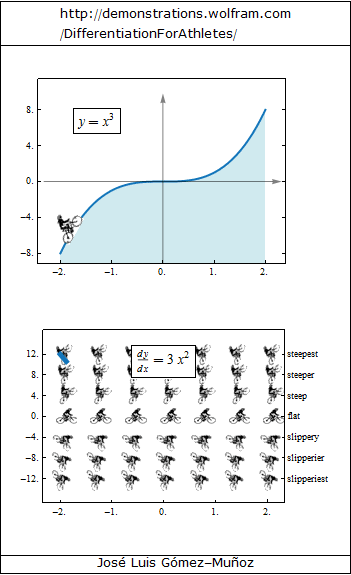November 24th, 2021 at 7:18 pm EDT
Americans largely do not understand higher mathematics concepts. They barely understand even basic math. Kin to illiteracy, “innumeracy” is a foundation for lifetimes of poor thought and ill decision. You might remember this corrective share from the early days of the pandemic: If you were to fold a standard 8 ½ x 11-inch piece of paper onto itself, you would only need to fold 42 times to stack a pile so high, that it’d reach the moon. 42 folds — cutting each new set of folded pieces for ease if you’d like to imagine it that way.
A huge majority of the height stacks nearest the end, almost 95% in just the last 4 of 42 folds, half on the last fold alone — and if you keep going, in fewer than just 100 folds, you’d get the diameter of the entire visible universe.
Like those folds does a highly transmissible virus spread, we learned. Depressingly, these anecdotes that are so hard to wrap our heads around aren’t upper-level math at all. Of course the distance doubles in each fold.
And the applications for the folding anecdote aren’t limited to coronavirus infection rates, either. Folds are like multiplying by “2” over and over. Compound interest works the same, but with 5 or 6% accruing instead of a doubling. Assuming you have the privilege, look no further than your own retirement or savings accounts. With every day, the new wealth produced the previous can produce even more for you, too. The “moonlike” track of even modest compound interest is alarmingly unintuitive, as John Oliver and Billy Eichner have explored.
At this point in the pandemic, everyone should know what a compound danger our R number is — but I think we all know, that we all don’t know. R is the most important snowball epidemiologists and leaders track, the “reproduction rate.” A virus, once safe in a host, infects on average R more people. When R is less than 1.0, the virus is dying out. At 2.0, the virus might quickly hit the diameter of the planet if we’re not careful.
R impacts our visible stats, like current infections and current deaths, but R itself also moves. One day R might be 2.0, the next 2.1, the next 2.3.
Calculus is how we track the changes of the change, otherwise known as a “derivate.”

Like a Steadicam, we can chart in a graphic a biker’s direction independent of how high or low they ultimately lie relative to sea level. That trace in calculus is the “derivative,” and is way more analytically beneficial than its homonym in a Wall Street bro’s playbook.
A shop owner should know the derivative of their profits, how quickly a sales trend is shifting up or down. A covid patient should consider not only how much their symptoms have worsened, but the rate at which they’re worsening.
An epidemiologist should know the covid-positive and death totals as much as which direction R is trending. A political leader, the same.
In health at least, this level of analysis hasn’t mattered much for the average American in past decades and wasn’t an issue of life or death. The old default of trusting doctors, data scientists, and other researchers has suffered major blows, the few political PhDs having polluted the pool of data and analysis. In the absence of returning to that trust — a moonshot, now — we’re left with getting the public to understand calculus statistics too, right alongside policymakers.
A world where misunderstanding mathematics and its sibling science has no consequence was always a fiction. Damage a fraction of what the disconnect in the pandemic has revealed was nonetheless real, if hidden. Consider the slog of enacting research-based approaches in policy, the lack of clear abortion messaging from the left on what “life” does mean, the failed climate change campaigns that could never successfully explain why a 0.1-degree change in global temperature should be terrifying.
Data science has always needed its own ad agency. The vacancy has just gone unnoticed until now.
Logicians and cognitive scientists have long identified the types of innumeracy mistakes to which the general public fall prey. “The Gambler’s Fallacy” is among the most common. Just because “4” hasn’t hit in a while, does not mean it’s more likely to hit soon. That’s not how probability works. There is no difference between a first spin of the roulette wheel, and the 67th when it comes to odds.
Blame falls not exclusively on the average American consumer and virus carrier. Statisticians have always had ingroup language to explain heady concepts to one another. That trend is nothing odd — it’s expertism, expressed when experts talk to other experts. Chemists understand chemists. Biologists mostly understand chemists. The layman understands neither. And when votes and health policy depend on communicating those concepts to people who understand nothing of the basics — and trust is only a memory — defaulting to normal lab-speak won’t do.
We have yet to create shortcuts in our language for conveying in shorthand a warning when you see someone falling for a fallacy like the Gambler’s. We have other shorthands that work just fine — “Hot!” “Puddle!” “Pothole!” “Ocupado!”— but for one of the most common misunderstandings we have, the holler looks more like, “You’re miscalculating as if the turns don’t reset probability every instance!”
So in the meantime, while we wrestle the pandemic among other collective tribulations, officials’ messaging remains exceedingly poor. A frustrated public, tired of occupancy restrictions and masking, is especially unfit to understand the numbers public health officials communicate as rationales for sometimes quickly shifting rules in a county — after all, “consistently shifting” is different than “quickly shifting” — calculus in an adverb.
Surprisingly effective are anecdotes and metaphors. Don’t count out sharable memes. The problem isn’t necessarily a difficult one to scale for those in the know or in communication, even if the content itself was first difficult to grasp.
It is not possible to communicate less effectively than we are now, which is not at all — and to calculate how we could go back in time to stop ourselves from copying our math homework, we’d need to be good at math.
Calculus is for nerds. It’s only applicable in STEM jobs.
THE SIFT
Calculus is for everyone. In absence of largely trusting STEM research, we’d do well to learn at least the fundamentals.
Ryan Derenberger is a freelance journalist and editor, a Journalism and AP Language teacher at Whitman HS in Bethesda, MD, and the founder of 'The Idea Sift.' He also serves on the board of directors for student journalism nonprofit 'Kidizenship.'












